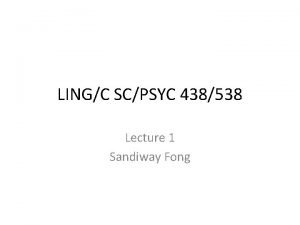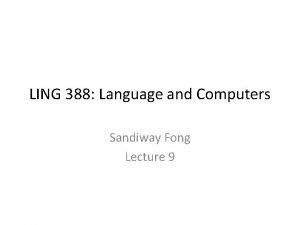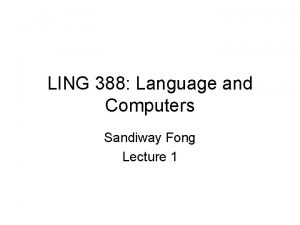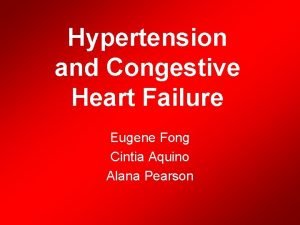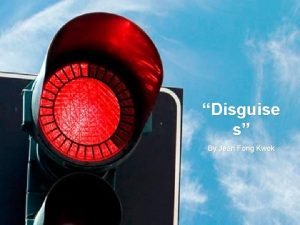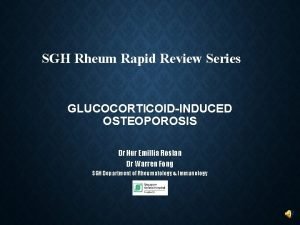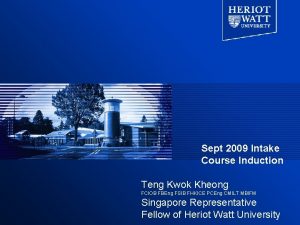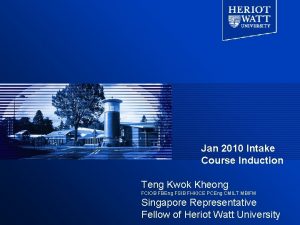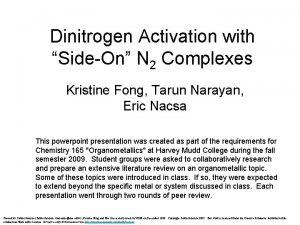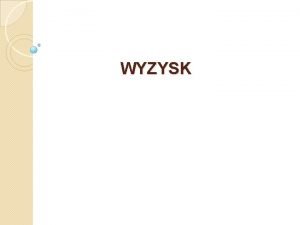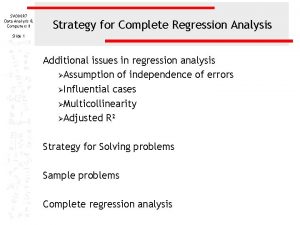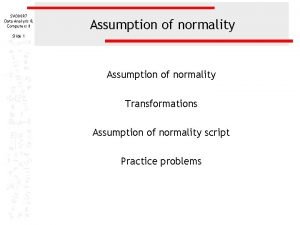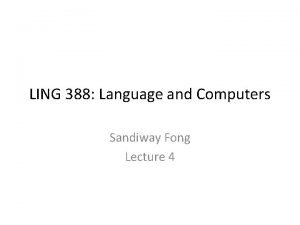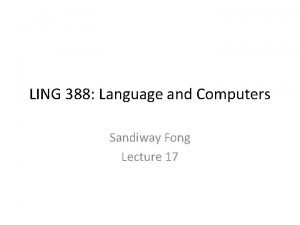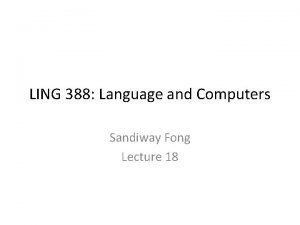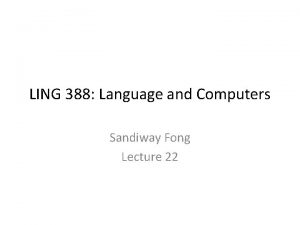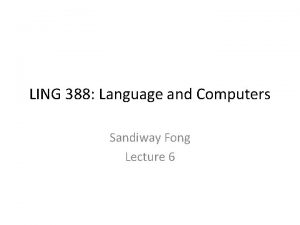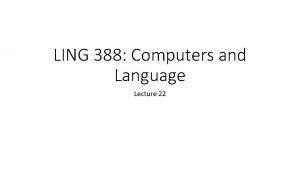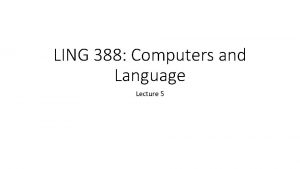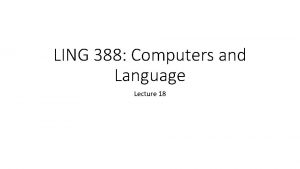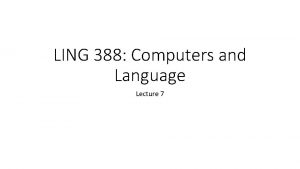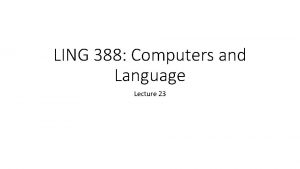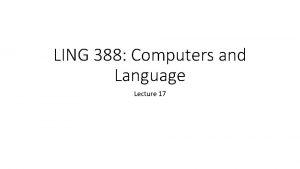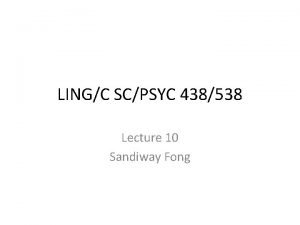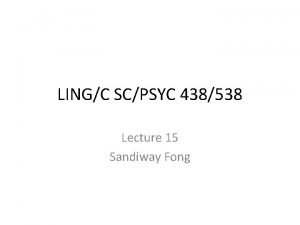LING 388 Language and Computers Sandiway Fong Lecture















![Step 1 • Part 1: x --> x, [y]. x --> [z]. – identify Step 1 • Part 1: x --> x, [y]. x --> [z]. – identify](https://slidetodoc.com/presentation_image_h/06158239fac64e7e22d986dbf0a6927d/image-16.jpg)
![Step 2 • Transformation: – x --> x, [y]. – x --> [z]. into Step 2 • Transformation: – x --> x, [y]. – x --> [z]. into](https://slidetodoc.com/presentation_image_h/06158239fac64e7e22d986dbf0a6927d/image-17.jpg)



- Slides: 20

LING 388: Language and Computers Sandiway Fong Lecture 12

Adminstrivia • Review: – Homework 4 on Recursion – Continue on with the left to right recursion grammar transformation: • Last Time: abstract grammar fragment • Today: PP adjunction to NP and VP

Homework 4 Review • Recursion type 1: – – – we can stack adjectives… the bus the big red bus the shiny big red bus (cf. the big shiny red bus) • Recursive rule: – right recursive rule – nn --> a, nn.

Homework 4 Review Start with grammar. pl from the course webpage: • nn(nn(A, NN)) --> a(A), nn(NN). • • • a(jj(big)) --> [big]. a(jj(shiny)) --> [shiny]. a(jj(red)) --> [red]. • nn(nn(bus)) --> [bus]. sentence(s(X, Y)) --> np(X), vp(Y). pp(pp(X, Y)) --> in(X), np(Y). in(in(with)) --> [with]. np(np(X)) --> prp(X). np(np(np(X, Y), Z)) --> det(X), nn(Y), pp(Z). np(np(D, NN)) --> det(D), nn(NN). prp(i)) --> [i]. prp(me)) --> [me]. nn(nn(boy)) --> [boy]. nn(nn(telescope)) --> [telescope]. vp(vp(V, X)) --> verb(V), np(X). vp(vp(V, X, Y)) --> verb(V), np(X), pp(Y). verb(vbd(saw)) --> [saw]. det(dt(the)) --> [the]. det(dt(a)) --> [a].

Homework 4 Review • Tree representation:

Homework 4 Review • Tree representation:

Homework 4 Review • Tree representation:

Homework 4 Review • Tree representation:

Homework 4 review • Recursion is a property of natural language – simple iteration: … big shiny red bus • Another kind of recursion – Some verbs can select for clauses (as well as object NPs), e. g. notice • I noticed that John noticed that Mary noticed the big red bus • [S I noticed [SBAR that [S John noticed [SBAR that [S Mary noticed the big red bus]]]]] Idea: some verbs can select for sentences introduced by the complementizer that

Homework 4 review • Example: – Mary noticed the big red bus 1. verb(vbd(noticed)) --> [noticed]. 2. np(np(X)) --> proper_noun(X). 3. proper_noun(nnp(mary)) --> [mary].

Homework 4 review • Example: – John noticed that Mary noticed the big red bus (IN that) 1. 2. 3. 4. vp(vp(V, SBAR)) --> verb(V), sbar(SBAR). sbar(C, S)) --> c(C), sentence(S). c(c(that)) --> [that]. proper_noun(nnp(john)) --> [john].

Homework 4 review • Example: – I noticed that John noticed that Mary noticed the big red bus

Homework 4 review • Example: – I noticed that John noticed that Mary noticed the big red bus

Today’s Topic • Exercise: – Convert left recursive natural language grammar rules into right recursive grammar rules

Step 1 • Recipe: 1. Let x be the nonterminal with the left recursion. 2. Let z be the terminal (or nonterminal) sequence that x also expands to 3. Let y be the terminal (and/or nonterminal) sequence after the left recursive call • Abstract example from last time: – x --> x, [y]. – x --> [z].
![Step 1 Part 1 x x y x z identify Step 1 • Part 1: x --> x, [y]. x --> [z]. – identify](https://slidetodoc.com/presentation_image_h/06158239fac64e7e22d986dbf0a6927d/image-16.jpg)
Step 1 • Part 1: x --> x, [y]. x --> [z]. – identify x, y, and z in the following rules: 1. np --> dt, nn. 2. np --> np, pp. – identify x, y, and z in the following rules: 3. vp --> vbd, np. 4. vp --> vp, pp.
![Step 2 Transformation x x y x z into Step 2 • Transformation: – x --> x, [y]. – x --> [z]. into](https://slidetodoc.com/presentation_image_h/06158239fac64e7e22d986dbf0a6927d/image-17.jpg)
Step 2 • Transformation: – x --> x, [y]. – x --> [z]. into – x --> [z], v. – v --> [y]. – x --> [z]. • Step 2: – apply transformation to: – np --> dt, nn. – np --> np, pp. also to: – vp --> vbd, np. – vp --> vp, pp.

Step 3 • Step 3: • Abstract example: – modify the grammar fragments from step 2 into grammars that compute parse trees – test your grammar fragments on VPs like saw a boy with a telescope – vp(Parse, [saw, a, boy, with, a, telescope], []). – x --> [z], v. – v --> [y]. – x --> [z]. modified version: – x(x(z, V)) --> [z], v(V). – v(v(y, V)) --> [y], v(V). – v(v(y)) --> [y]. – x(x(z)) --> [z].

Comparison • “Quick Fix” grammar from last time: • Result:

Step 4 • Step 4: – Compare the transformed grammar parses with those obtained using the “Quick Fix” grammar on the NP • a boy with a telescope with a limp • number of parses? • attachment of the PPs?
 Google translaze
Google translaze Swi prolog examples
Swi prolog examples Sandiway fong
Sandiway fong 01:640:244 lecture notes - lecture 15: plat, idah, farad
01:640:244 lecture notes - lecture 15: plat, idah, farad Timothy fong ucla
Timothy fong ucla Eugene fong
Eugene fong Bruce fong dts
Bruce fong dts Disguises jean fong kwok
Disguises jean fong kwok Caroline fong
Caroline fong Moy fong menu
Moy fong menu Fion fong
Fion fong Irene fong
Irene fong Dr warren fong
Dr warren fong Hwu timetable
Hwu timetable Hwu webmail
Hwu webmail Kristine fong
Kristine fong Art 388 kc
Art 388 kc Wac 388-877
Wac 388-877 Sw 388
Sw 388 388*7
388*7 388 hymn
388 hymn
